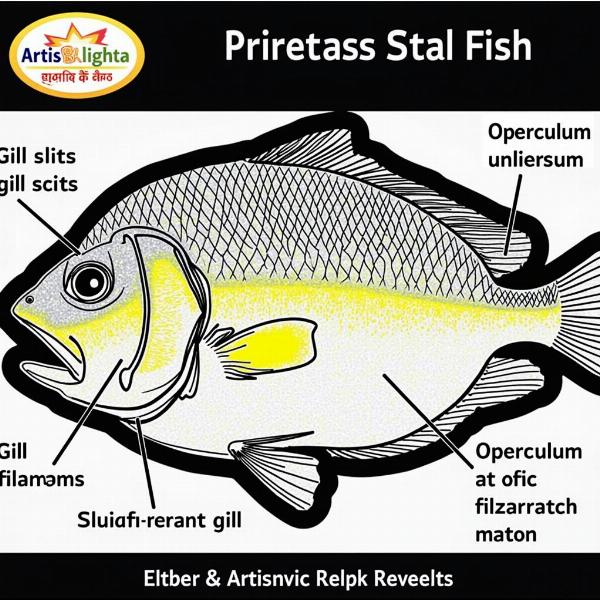Gill slits, those intriguing structures we often associate with fish, hold a fascinating biological significance. But what exactly does “gill slits” mean in Hindi? This comprehensive guide will explore the meaning, function, and evolutionary significance of gill slits, providing you with a clear understanding of this important biological concept. We’ll delve into the Hindi terminology and cultural context surrounding aquatic life, offering a nuanced perspective for Indian readers.
Understanding Gill Slits: मछली के गलफड़े (Machhli ke Galphade)
In Hindi, gill slits are commonly referred to as “मछली के गलफड़े” (Machhli ke Galphade), which literally translates to “fish gills.” While this term accurately describes the location and general appearance of gill slits, it doesn’t fully capture their complex function. Gill slits are more than just openings; they are intricate structures that facilitate respiration in aquatic animals. They allow fish to extract oxygen from the water and expel carbon dioxide, a process crucial for their survival.
 Fish Gill Slits Diagram
Fish Gill Slits Diagram
The Function of Gill Slits: How Fish Breathe
Gill slits are essential for aquatic respiration. Water flows over the gill filaments within the slits, allowing oxygen to diffuse into the fish’s bloodstream. Simultaneously, carbon dioxide is released from the blood into the water and expelled. This exchange of gases is fundamental to the fish’s metabolic processes. The number and structure of gill slits can vary depending on the species and its environment.
Gill Slits in Embryology: भ्रूणविज्ञान में गलफड़े (Bhrunvigyan mein Galphade)
Interestingly, gill slits also appear in the early embryonic stages of many vertebrates, including humans. This doesn’t mean human embryos have functional gills, but rather reflects our shared evolutionary history with aquatic ancestors. The presence of gill slits in embryos provides evidence of the evolutionary pathways that have shaped life on Earth. In Hindi, this embryonic stage is discussed in the context of “भ्रूणविज्ञान” (Bhrunvigyan), or embryology.
Evolutionary Significance: विकासात्मक महत्व (Vikasatmak Mahatva)
The presence of gill slits in diverse species underscores their evolutionary significance. They serve as a testament to the common ancestry of many vertebrates, tracing back to aquatic origins. Over time, these structures have adapted and evolved to suit the specific respiratory needs of different organisms, reflecting the power of natural selection. In Hindi, this evolutionary perspective is encapsulated by the term “विकासात्मक महत्व” (Vikasatmak Mahatva), emphasizing the importance of these structures in understanding the development of life.
Gill Slits Beyond Fish: मछली से परे गलफड़े (Machhli se Pare Galphade)
While we primarily associate gill slits with fish, they are also found in other aquatic animals like some amphibians and invertebrates. These structures demonstrate the diverse ways in which organisms have adapted to breathe in aquatic environments, showcasing the remarkable ingenuity of nature.
Conclusion: Understanding the Importance of Gill Slits
Gill slits, known as “मछली के गलफड़े” (Machhli ke Galphade) in Hindi, are crucial respiratory structures in fish and other aquatic animals. Their presence in embryos also provides valuable insights into evolutionary relationships. Understanding the function and significance of gill slits enhances our appreciation for the intricate workings of the natural world.
FAQ:
- What is the primary function of gill slits? Gill slits facilitate the exchange of oxygen and carbon dioxide in aquatic animals, allowing them to breathe underwater.
- Why do human embryos have gill slits? Gill slits in human embryos are a vestigial structure, a remnant of our evolutionary past, reflecting our shared ancestry with aquatic organisms.
- What is the Hindi word for gill slits? The common Hindi term for gill slits is “मछली के गलफड़े” (Machhli ke Galphade).
- Are gill slits found in animals other than fish? Yes, gill slits are also found in some amphibians and invertebrates.
- What is the evolutionary significance of gill slits? Gill slits provide evidence of common ancestry among vertebrates and demonstrate the adaptive evolution of respiratory structures.
- What is the difference between gill slits and lungs? Gill slits extract oxygen from water, while lungs extract oxygen from air. Both are essential respiratory organs adapted to different environments.
- How do gill slits work? Water flows over the gill filaments within the slits, allowing oxygen to diffuse into the bloodstream and carbon dioxide to be expelled.
Meaning-Hindi.in offers professional translation services in a variety of fields, including business, legal, technical, website localization, and academic translation. Whether you need fast and accurate document translation or specialized linguistic expertise, our team is ready to assist you. From translating business contracts to academic research papers, Meaning-Hindi.in provides high-quality language solutions tailored to your specific needs. Contact us today for a free quote at [email protected] or call us at +91 11-4502-7584. Let Meaning-Hindi.in be your trusted partner for all your Hindi translation requirements.